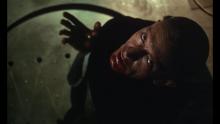These notes on Stuart Gordon's Dagon were written by David Vanden Bossche, PhD candidate in UW Madison’s Department of Communication Arts. A 35mm print of Dagon will screen in our ongoing Gordon retrospective at the Chazen Museum of Art on Sunday, October 23 at 2 p.m. A 35mm print from the Stuart Gordon collection at the Wisconsin Center for Film and Theater Research will be shown.
By David Vanden Bossche
In the wake of horror’s promotion to a commercially viable blockbuster-genre with such titles as Rosemary’s Baby (1968), The Exorcist (1973) and The Omen (1976), the seventies also witnessed the rise of more extreme genre fare that produced a sub-cycle of films aimed at more adventurous afficionados: The Texas Chainsaw Massacreor Last House on the Left are just two of the most famous incarnations of this trend. With the exponential growth of the home video market at the end of the decade leading to a wider distribution for these films (and infamously to the ‘video nasties’ law in the UK that banned certain titles from video stores) a slew of directors who had built their reputations within this niche, stepped forward and injected the commercially oriented horror market with new levels of gore and violence. Most prominent was Sam Raimi whose Evil Dead set the tone in 1981, but in his wake Wes Craven (director of The Hills Have Eyes who launched the Nightmare on Elm Street series), Tobe Hooper (Chainsaw’s director channeling his more extreme approach into ‘mainstream’ fare like the Steven Spielberg-produced Poltergeist) and George A. Romero (going from his seminal Night of the Living Dead trilogy to the likes of Creepshow in 1982) successfully worked their horror-sensitivities into films that attracted bigger audiences.
Somewhat of an outlier because he entered the scene relatively late, is UW Madison alumnus Stuart Gordon, who took the horror film world by storm when his 1985 H.P. Lovecraft adaptation Re-Animator won a critics’ award at the prestigious Cannes Film Festival. Gordon would twice return to the work of Lovecraft, first in 1986 for From Beyond and again over a decade later for Dagon in 2001. The 1931 novella at the basis of Dagon – The Shadow over Innsmouth – is one of the famous author’s most enduring stories, even inspiring horror maestro Stephen King to write the homage Crouch End in his 1993 collection of short stories Nightmares & Dreamscapes. Curiously, the material failed to produce a Hollywood film adaptation, though there was a failed early 70’s attempt by famed producer Roger Corman. Gordon tried to bring the story to the screen a first time in 1991 but would have to wait another decade before he was able to secure Spanish funding for his long-gestating project.
Even though the title refers to an earlier Lovecraft story from 1919, Dagon’s screenplay remains mostly faithful to The Shadow over Innsmouth, save of course for the change of scenery that now situates the strange village at the heart of the story somewhere along an anonymous Spanish coastline. Drawing from Lovecraft’s Cthulu mythos, Gordon’s Dagon tells the ominous tale of a young couple (played by Ezra Godden and Spain’s then-popular soap star Raquel Meroño) mysteriously shipwrecked near the fishing village of Imboca, where they not only find the inhabitants to be gruesomely frightening but also tied to their own heritage in ways they could scarcely imagine. Building a suffocating atmosphere of dread, Gordon and Carlos Suárez, his director of photography, forego any of the sun-drenched imagery we tend to associate with the Spanish coastal locale and dress the film in fog-imbued tones of murky greys and browns. That is, until the decidedly surreal dreamscapes that dominate the latter half of this grim nightmare take over and set up an almost operatic explosion of heightened color, rife with deceptively enchanting blues and of course lavish portions of red.
Most interesting, however, is the masterful production design by Llorenç Miquel, the art director who would subsequently work with Jaume Balagueró for 2002’s Darkness and with Brian Yuzna a year later for the ill-advised sequel Beyond Re-Animator. Teaming up with make-up artist Monte Boqueras and Catou Verdier, a regular Miquel collaborator and costume designer with whom he had worked on Jack Sholder’s Arachnid (2001), Miquel manages to breathe life into the daunting and hellish worlds that came out of H.P. Lovecraft’s imagination. We can see the team’s superb non-CGI (computer generated imagery) craft at work in the wild fantasies brought to live in the baroque finale, but also ever so subtly in the early parts of the film in which slight bodily deformations and creepy features betray the non-human nature of the villagers and foreshadow the impending doom.
Director Stuart Gordon, for his part, is back to working his magic with horror movies after a few uncharacteristic departures from the genre like the sci-fi satire Space Truckers (1997) and the whimsical Ray Bradbury adaptation The Wonderful Ice Cream Suit (1999). While less playful and tongue-in-cheek than Gordon’s early features like Re-Animator and From Beyond, Dagon shares with these early films the filmmaker’s prolific visually imaginative work and his mastery of narrative rhythm. Dagon runs a scant 90 minutes not counting the end credits, but that running time is filled to the brim with swift action and horror, brought vividly to life by some excellent hand-held camerawork. From the get-go – a scene at sea that plunges us straight into the drama – this is a thrill-ride that submerges the viewer in a nightmare that never lets up.
As a final observation, it is worth noting that Dagon contains the final screen appearance of actor Francisco Rabal, whose eclectic career includes such legendary titles as Viridiana (1961), L,Eclisse (1962) and La Religieuse (1966), but also a long list of completely forgotten low-budget outings. Rabal died shortly after completing the film and Gordon dedicates Dagon to his memory just before the end credits roll.










